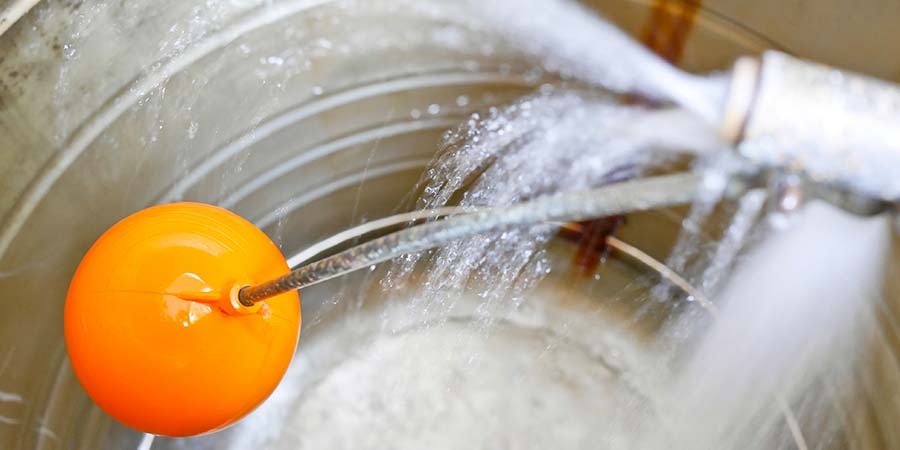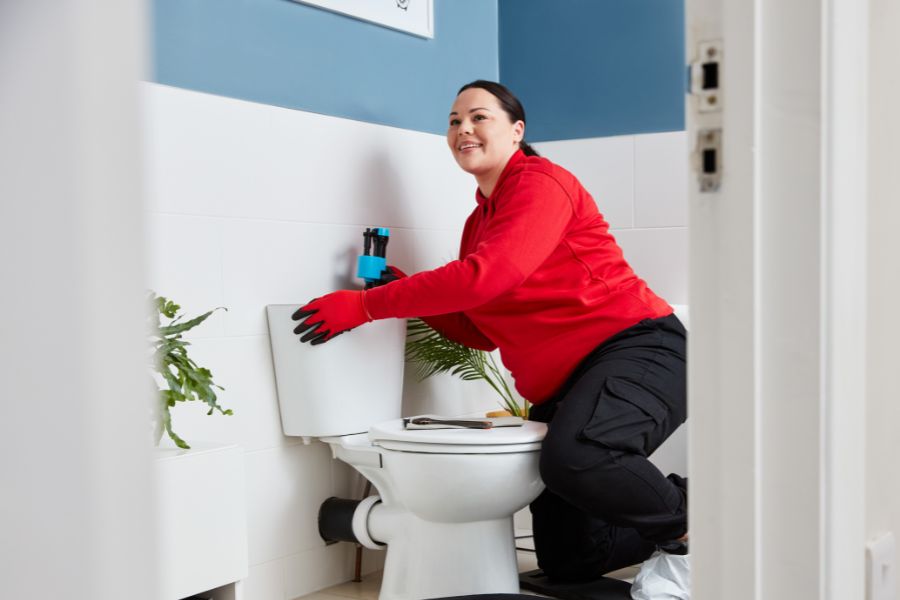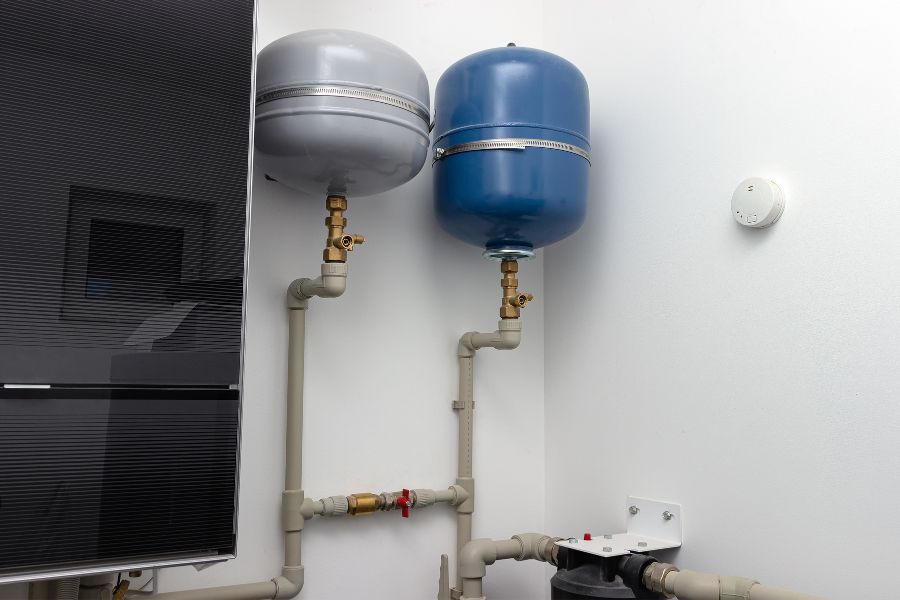In this article:
- What is an overflow pipe?
- Why is my overflow pipe leaking?
- How to fix a leaking overflow pipe
- Why is my toilet overflow pipe leaking?
- Why is my cold water feed and expansion tank overflow pipe leaking?
- Why is my overflow from central heating feed and expansion tank leaking?
- Why is my overflow from a copper cylinder leaking?
- Why is my boiler overflow pipe leaking?
- Why is my sink overflow pipe leaking?
- Why is my overflow pipe leaking outside?
What is an overflow pipe?
An overflow pipe leads from a water storage tank or cistern inside your home to the outside.
If the water in the tank or cistern fills up to a higher level than it should, the excess water flows down through the overflow pipe and runs outside, rather than leaking into your home.
Some of the most common components in your home that require an overflow pipe are
- Toilet cistern
- Cold water feed and expansion tank
- Central heating feed and expansion tank
- Combination boiler
- Copper cylinder
- Sinks, basins and baths
Why is my overflow pipe leaking?
When an overflow pipe is leaking or dripping, it may be due to a problem with a float valve.
Float valves are found in toilet cisterns, cold water tanks, and central heating feed and expansion tanks.

If the float valve doesn’t operate properly, the cold-water feed may not fully switch off which causes the water level to continue to rise above the overflow. This causes an issue because the maximum water level in the tank should be about one inch below the overflow pipe.
How to fix a leaking overflow pipe
Although diagnosing leaky pipes can be tricky, if you’re not sure where your leak is coming from, it’s best to check before you try to make any fixes. If you suspect that it’s your overflow pipe that’s leaking, try following the steps below to fix your issue.
1. Identify which water tank or cistern is overflowing
If the leaking pipe is at ground or first-floor level, then it’s likely to be your bathroom overflow pipe dripping water from the toilet cistern. However, if it’s at loft level and protrudes from the eaves of the roof, then it could be coming from your cold-water or central heating feed and expansion tank.
Check the water level in each of these tanks if you’re still unsure. If the water level is close to the overflow – or higher than the ring of limescale that indicates its usual level – then you’ve found the culprit.
Top tip: If there’s only a small amount of water dripping into your cistern or tank, you may only notice it early in the morning.
2. Check the float valve
If water is running continuously into the tank, the float valve could be stuck in an open position.
Lift it up to release it and check nothing is stopping it from moving freely. If it’s moving with no problems, check the plastic ball isn’t punctured and filled with water, in which case, it will need to be replaced.
If neither of these are the problem, and the water still doesn’t shut off, the washer may be worn and in need of replacement.
3. Turn off the water feed and drain the water
If you’ve identified that there’s a problem with your float valve, you’ll need to replace it or replace the washer as mentioned above. First, you’ll need to stop the flow of new water into the tank and drain it so you can work.
- To turn the water feed off on a toilet cistern, use the isolation valve – this is a valve located on the water pipe that leads into the cistern
- Use a flat-head screwdriver to turn the screw a quarter turn clockwise
- Flush the toilet to drain the water
- Stop the water feed into either of the water tanks by turning off the main water supply at the stopcock
- Drain the water by turning on your bathroom taps, just enough so that the water level is below the area you need to work on
Your next steps will depend on what’s leaking and why.
Why is my toilet overflow pipe leaking?

If your toilet overflow pipe is leaking outside, it’s because the water feed into the cistern isn’t switching off. But don’t worry, there are lots of possible fixes for this.
How to fix a leaking toilet overflow pipe
1. Check the float valve isn’t stuck (as described above)
It could also be tangled up in the chain that pulls open the flapper valve when you flush.
2. Adjust the position of the float
The height required for the ball to shut the water feed off may be set too high. If the arm is metal, try lowering the ball’s height by bending the arm down. If it’s plastic, you’ll find an adjustment screw at the top of the arm. Turn it slightly to move the position of the float.
3. Check the water feed pressure
The overflow pipe could be leaking because the pressure of the water coming into the tank is too high. Use the isolation valve (see steps 1 and 2 above) to reduce the flow of water.
4. Replace the washer in the float valve
If the water feed still isn’t completely shutting off once the cistern is full, try changing the washer. First, turn off the water supply and drain the cistern (as described above). Take the float valve apart and remove the old washer. Take the old washer to a DIY store when you get the replacement to ensure you get the right size. Put the new washer in and put the float valve back in place.
5. Replace the float valve
If the float valve is damaged or there’s a puncture in the plastic ball, it will need to be replaced. Again, shut the water supply off and drain the cistern (as described in step 5 above). Remove the float valve and take it to a DIY store when you get the replacement to ensure you get the right size. You can now install the new float valve.
Why is my cold water feed and expansion tank overflow pipe leaking?
If your cold water feed and expansion tank overflow pipe is leaking, there are two possible causes:
- The water feed into the tank isn’t switching off
- Water is being pushed back up the outlet pipes
The water feed into the tank isn’t switching off
Look inside the tank. If you can see water constantly running or dripping from the water feed, check if the float valve is stuck.
If needed, adjust the position of the float, replace the washer or replace the float valve.
Water is being pushed back up the outlet pipes
If your float valve is working fine, and the cold water feed to the tank switches off when it should, then excess water can only be coming back up through the outlet pipes. These are the pipes that feed water into your taps and water cylinder.
This is caused by a faulty mixer shower or tap that’s plumbed into the mains water feed. If this is the case, you may notice that the overflow pipe only leaks when you use the faulty tap or shower.
For this problem, it’s best to call out a professional plumber who can diagnose the problem and fix it for you.
Why is my central heating feed and expansion tank overflow pipe leaking?
If your central heating feed and expansion tank overflow pipe is leaking, there are two possible causes:
- The water feed into the tank isn’t switching off
- There is a problem with your hot water cylinder
The water feed into the tank isn’t switching off
When you look inside the tank, can you see water constantly running or dripping from the water feed? If so, ensure that the float valve isn’t stuck or doesn’t need adjusting.
Alternatively, it may be that the washer or whole float valve needs replacing.
There is a problem with your hot water cylinder
If your float valve is working fine, and the cold water feed to the tank switches off when it should, then the only other cause is a problem with your hot water cylinder. Read the next section to find out more.
Why is my copper cylinder causing an overflow pipe to leak?

There are two possible reasons for your copper cylinder to be causing an overflow pipe to leak:
- The temperature on your thermostat is too high
- The coil inside the copper cylinder is perforated
The temperature on your thermostat is too high
It’s normal for the overflow pipe on a copper cylinder to drip when your water is heating. But if you find it’s running with water and causing your tank to overflow, then your water could be getting too hot. To fix this, simply adjust the temperature on your thermostat down a little.
The coil inside the copper cylinder is perforated
Inside the copper cylinder, there’s a coil that’s supplied with hot water from the boiler. The rest of the copper cylinder is supplied with cold water from the cold water storage tank.
An overflow problem occurs when there is a perforation in the coil, and the water inside it leaks out into the main cylinder. When this happens, the domestic water (that supplies your cold taps and toilets) and the central heating water (that supplies your hot taps, boiler and radiators) mix.
Gravity tries to equalise the water level between the cold water feed and expansion tank and the central heating feed and expansion tank – and since the central heating tank has a lower water level to start with, it’s usually this tank that fills above its normal level and overflows.
The only solution for this problem is to replace the copper cylinder. It’s best to call out a professional plumber who can carry out the work for you.
Why is my boiler overflow pipe leaking?
Combination boilers have a pipe that’s similar to an overflow pipe, called a pressure relief valve. This valve releases water if the system builds up too much pressure.
Your boiler’s overflow pipe may leak water if:
- The boiler has built up too much pressure due to the expansion vessel failing or losing its charge
- The pressure relief valve is not seated correctly, causing water to pass by it
For safety reasons, it’s best to call out a Gas Safe registered engineer who can come and fix this problem for you to avoid a boiler breakdown.
Why is my sink overflow pipe leaking?
The overflow on a sink is a small opening that’s found on the back of the sink, just below the rim and is connected to a pipe that leads down into the drain. These overflows are found in bathroom basins, baths and kitchen sinks, and help to stop your sink overflowing if you leave the tap running when the plug is in.
Unlike other overflows, you will see the problem in the sink itself rather than notice a dripping overflow pipe outside your house.
The simple solution to an overflowing sink is to pull the plug out and allow the bowl to drain.
Why is my overflow pipe leaking outside?
If you see an overflow pipe leaking outside, the likely cause is:
- An overflowing toilet cistern
- The cold water or central heating feed and expansion tank
- Your boiler overflow pipe is dripping due to a faulty combination boiler (please keep in mind that this could also be caused by your copper cylinder since they are connected!)
If a basin, bath, or kitchen sink overflow pipe is leaking, you won’t see this outside as these pipes lead directly down the drain.
Don’t let a burst pipe or blocked drain slow you down
Investing in reliable plumbing and drainage cover can take a huge weight off your mind—especially when it comes to unexpected plumbing emergencies.
Starting from just 50p a month, HomeServe’s plumbing and drainage cover gives you peace of mind and access to a nationwide network of trusted engineers. So you can kick back, relax, and let the experts take care of your plumbing.
Read our disclaimer




